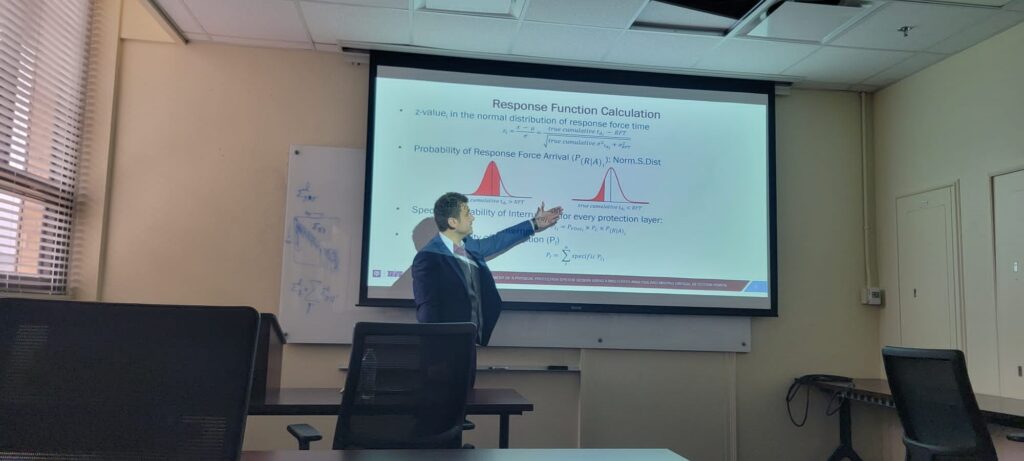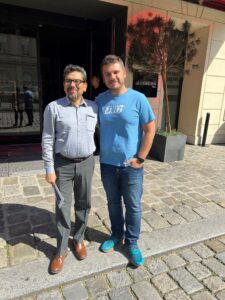The physical protection system (PPS) at a nuclear facility is designed to protect critical assets from malicious acts by potential adversaries. It usually consists of elements that provide deterrence, detection, delay, response, and recovery to prevent adversaries from carrying out a successful attack on the facility. To ensure that a facility’s PPS is capable of adequate protection, its effectiveness must be analyzed and evaluated. The standard method of determining the effectiveness of a PPS is the estimate adversary sequence interruption (EASI) model developed by Sandia National Laboratory. This method is focused on determining the effectiveness based on a single adversary sequence path that represents the most vulnerable path to a given target.

Melih Ozkutuk is a recent M.S. graduate who worked with Center for Nuclear Security Science and Policy Initiatives (NSSPI) Director Dr. Sunil Chirayath to develop a more versatile method for evaluating PPS effectiveness. “My research,” said Ozkutuk, “focuses on vulnerability assessment and the modeling of PPSs for nuclear materials and facilities against an adversary attacking the facility based on different adversary strategies including insider threats.” He went on to explain how critical this work is to securing nuclear facilities worldwide. “The consequence of numerous adversary attacks happening all over the world recently,” he elaborated, “has led the IAEA to give special attention to the criteria of a security system for nuclear power plants.”
In his work, Ozkutuk developed a stochastic approach (Monte Carlo) script to perform a multi-path analysis based on an adversary sequence diagram, a chart that enumerates all potential paths to the critical target. Since the EASI method does not estimate uncertainty in its evaluation, he also included this critical calculation in his modeling. Furthermore, he incorporated a non-fixed critical detection point into the EASI model. The critical detection point for PPS evaluation represents the point along an adversary sequence path after which the interruption of the attack is no longer possible. According to Ozkutuk, moving the critical detection point enables “the analysis of the different types of actions adversaries take to achieve their goals based on their perception of the PPS.” In all, these additions to the PPS evaluation led to a more realistic estimate of PPS risk that takes into consideration more complex adversary actions and corresponding uncertainties.
Through the development of his model, Ozkutuk studied the cost relationship between the total detection elements and the probability of interruption value, which is the likelihood of interrupting an adversary attack and represents the measure of effectiveness in a PPS. This is something he indicated was being done “for the first time.” He also analyzed the probability of detection elements using different types of distributions. Ozkutuk believes that, as a result of his work, designers can gain a wider perspective on potential adversary actions and a deeper understanding of the consequences of those malicious attacks.

Ozkutuk graduated from Texas A&M with a M.S. in nuclear engineering with a specialization in nuclear nonproliferation in May of 2023. “I had the opportunity to meet top individuals in the nuclear security industry through NSSPI during my education,” he explained. Ozkutuk said that through NSSPI he had the opportunity to visit numerous national laboratories and meet with people who are pioneers in the field of nuclear engineering. “Specifically,” he said, “I found the visit to the Sandia National Lab Nuclear Security Technology Complex to be significant for keeping abreast of the latest methods of physical security.” He was also able to present his master’s research at the INMM/ESARDA Joint Annual Meeting in Vienna.
Before joining NSSPI, Ozkutuk graduated from Eskisehir Osmangazi University in Turkey with a B.S. in Mechanical Engineering. He earned a master’s degree in the same field at Marmara University while working as a researcher on various scientific projects. He is now working for the Ministry of Energy and Natural Resources of the Republic of Türkiye.